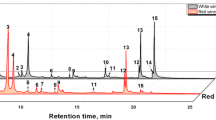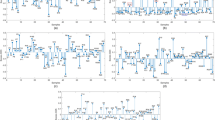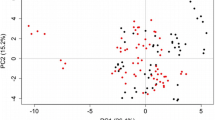Abstract
An electronic nose-mass spectrometry (EN-MS) that profiles volatile compounds is a candidate device for identifying the geographic origin of cultivation of agricultural products when an adequate algorithm is derived. The objectives of this study were to apply two types of multivariate analysis, discriminant function analysis (DFA) and principal component analysis (PCA), to the volatile compounds detected by an EN-MS for the geographic classification of Chinese cabbage cultivated in Korea (42 samples) or in China (29 samples). DFA showed that Chinese cabbage from Korea were completely separable from those originating in China with 12 volatile compounds among the 151 detected. PCA revealed that Chinese cabbage data fell into two completely separable origins of Korea and China. This is the first study involving EN-MS data of volatile compounds with multivariate statistics to discriminate the geographical origin of Chinese cabbage, with further applications for other agricultural products.




Similar content being viewed by others
References
Park SH, Jung SH, Lee KM, Kim TH, Cho JE. 2015 Trend of Kimchi industry. World Institute of Kimchi., Gwangju, pp. 28–29 (2016).
statistics. Ministry of Agriculture, Food and Rural Affairs, Sejong, pp. 72–85 (2015)
Peris M, Escuder-Gilabert E. A 21st century technique for food control: Electronic noses. Anal Chim Acta. 638: 1–15 (2009)
Pillonel L, Ampuero S, Tabacchi R, Bosset J. Analytical methods for the determination of the geographic origin of Emmental cheese: volatile compounds by GC/MS-FID and electronic nose. Eur Food Res Technol. 216: 179–183 (2003)
Ampuero S, Bogdanov S, Bosset JO. Classification of unifloral honeys with an MS-based electronic nose using different sampling modes: SHS, SPME and INDEX. Eur Food Res Technol. 218: 198–207 (2004)
Afifi A, May S, Clark VA, Practical Multivariate analysis. CRC Press (2011)
Reeves JB, Zapf CM. Mid-infrared diffuse reflectance spectroscopy for discriminant analysis of food ingredients. J. Agr. Food Chem. 46: 3614–3622 (1998)
Yang H, Irudayaraj J, Paradkar MM. Discriminant analysis of edible oils and fats by FTIR, FT-NIR and FT-Raman spectroscopy. Food Chem. 93: 25–32 (2005)
Murphy TB, Dean N, Raftery AE. Variable selection and updating in model-based discriminant analysis for high dimensional data with food authenticity applications. Ann Appl Stat. 4: 396 (2010)
Bryant DK, Monté S, Man WJ, Kramer K, Bugelski P, Neville W, White IR, Camilleri P. PCA of mass spectra of peptides generated from the tryptic digestion of protein mixtures. Rapid Commun Mass Spectrom. 15: 418–427 (2001)
Mari A, Montoro P, Pizza C, Piacente S. Liquid chromatography tandem mass spectrometry determination of chemical markers and principal component analysis of Vitex agnus-castus L. fruits (Verbenaceae) and derived food supplements. J Pharm Biomed Anal. 70: 224–230 (2012)
Gao B, Lu Y, Sheng Y, Chen P, Yu L. Differentiating organic and conventional sage by chromatographic and mass spectrometry flow injection fingerprints combined with principal component analysis. J. Agr. Food Chem. 61: 2957–2963 (2013)
Lu R. Detection of bruises on apples using near-infrared hyperspectral imaging. Trans ASAE. 46: 523–530 (2003)
Xing J, De Baerdemaeker J. Bruise detection on ‘Jonagold’ apples using hyperspectral imaging. Postharvest Biol Technol. 37: 152–162 (2005)
Xing J, De Baerdemaeker J. Fresh bruise detection by predicting softening index of apple tissue using VIS/NIR spectroscopy. Postharvest Biol Technol. 45: 176–183 (2007)
Qin J, Burks TF, Kim MS, Chao K, Ritenour MA. Citrus canker detection using hyperspectral reflectance imaging and PCA-based image classification method. Sens Instrum Food Qual Saf. 2: 168–177 (2008)
Lü Q, Tang MJ, Cai JR, Zhao JW, Vittayapadung S. Vis/NIR hyperspectral imaging for detection of hidden bruises on kiwifruits. Czech J Food Sci. 29: 595–602 (2011)
Picone G, Mezzetti B, Babini E, Capocasa F, Placucci G, Capozzi F. Unsupervised principal component analysis of NMR metabolic profiles for the assessment of substantial equivalence of transgenic grapes. J. Agr. Food Chem. 59: 9271–9279 (2011)
Gantumar G, Jo MH, Igori D, Ham IK, Lee EM, Lee WH, Lim YP, An GH, Park JT. Nutritional evaluation and comparison of new pak choi cultivars from china with chinese cabbage cultivars popular in Korea. Prev Nutr Food Sci. 42: 1412–1418 (2013)
Grieger JA, Scott J, Cobiac L. Cluster analysis and food group consumption in a national sample of Australian girls. J Hum Nutr Diet. 25: 75–86 (2012)
Wirfält E, Mattisson I, Gullberg B, Berglund G. Food patterns defined by cluster analysis and their utility as dietary exposure variables: a report from the Malmö Diet and Cancer Study. Public Health Nutr. 3: 159–173 (2000)
Oliveros CC, Boggia R, Casale M, Armanino C, Forina M. Optimisation of a new headspace mass spectrometry instrument Discrimination of different geographical origin olive oils. J Chromatogr A. 1076: 7–15 (2005)
Acknowledgements
This research was supported by the Golden Seed Project (Project Code: 213002-04-1-CGX00), Ministry of Agriculture, Food and Rural Affairs (MAFRA), Ministry of Oceans and Fisheries (MOF), Rural Development Administration (RDA), and Korea Forest Service(KFS).
Author information
Authors and Affiliations
Corresponding author
Ethics declarations
Conflict of interest
The authors declare no conflict of interest.
Rights and permissions
About this article
Cite this article
Lee, WH., Choi, S., Oh, IN. et al. Multivariate classification of the geographic origin of Chinese cabbage using an electronic nose-mass spectrometry. Food Sci Biotechnol 26, 603–609 (2017). https://doi.org/10.1007/s10068-017-0102-6
Received:
Revised:
Accepted:
Published:
Issue Date:
DOI: https://doi.org/10.1007/s10068-017-0102-6




